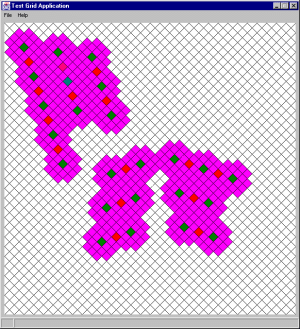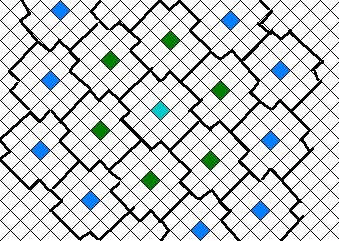Beard Rinker
Warlord
In the optimal city layout, all terrain squares are used and each city has only 2 overlapping tiles with other cities. Each city effectively has use of 20 tiles and no terrain squares are wasted.
When establishing the optimal pattern, there are three placements in any direction for the second city. Once the second city is placed the pattern is established and this dictates the placement of the other cities.
The placements are:
a) Five tiles adjacent.
b) Three tiles diagonal then 1 tile diagonal left or right.
c) Three tiles diagonal then 1 tile adjacent left or right.
To continue the pattern, cities placed left or right of the second city must be done as follows:
- Use the 2 placements not used when placing cities on the left or right of city 2.
- If placement a is used then placement b and c must hook away from the second city. For example: City 2 is 5 tiles ne of city 1 using placement a. City 3 is 3 tiles north, 1 tile west (away). City 4 is 3 tiles east, 1 tile se (away). Alternately, city 3 is 3 tiles n, 1 tile nw. City 4 is 3 tiles east, 1 tile s.
- If placement b or c are used then the right and left placement must use a specific pattern. Use placement a in the opposite side of the hook on city 2's placement. Use the other placement on the other side hooking towards city 2. For example: City 2 was place using placement 2 and is 3 tiles north, 1 tile w. City 3 would then be on city 2's right and placed 5 tiles ne of city 1. City 4 would use placement c and be 3 tiles e, 1 tile ne of city 1.
To continue the pattern from the second city in the same direction the exact same placement pattern must be used. For example: City 2 is placed using placement b and is 3 tiles south, 1 tile west. Continuing south from city 2 the next city must be 3 tiles south one tile west. Alternately, it could be 5 tiles se but that's not as south.
The attached image shows a hypothetical optimal city placement pattern.
Legend:
Green City
Pink Area in use by city
Red Overlap between 2 cities
When establishing the optimal pattern, there are three placements in any direction for the second city. Once the second city is placed the pattern is established and this dictates the placement of the other cities.
The placements are:
a) Five tiles adjacent.
b) Three tiles diagonal then 1 tile diagonal left or right.
c) Three tiles diagonal then 1 tile adjacent left or right.
To continue the pattern, cities placed left or right of the second city must be done as follows:
- Use the 2 placements not used when placing cities on the left or right of city 2.
- If placement a is used then placement b and c must hook away from the second city. For example: City 2 is 5 tiles ne of city 1 using placement a. City 3 is 3 tiles north, 1 tile west (away). City 4 is 3 tiles east, 1 tile se (away). Alternately, city 3 is 3 tiles n, 1 tile nw. City 4 is 3 tiles east, 1 tile s.
- If placement b or c are used then the right and left placement must use a specific pattern. Use placement a in the opposite side of the hook on city 2's placement. Use the other placement on the other side hooking towards city 2. For example: City 2 was place using placement 2 and is 3 tiles north, 1 tile w. City 3 would then be on city 2's right and placed 5 tiles ne of city 1. City 4 would use placement c and be 3 tiles e, 1 tile ne of city 1.
To continue the pattern from the second city in the same direction the exact same placement pattern must be used. For example: City 2 is placed using placement b and is 3 tiles south, 1 tile west. Continuing south from city 2 the next city must be 3 tiles south one tile west. Alternately, it could be 5 tiles se but that's not as south.
The attached image shows a hypothetical optimal city placement pattern.
Legend:
Green City
Pink Area in use by city
Red Overlap between 2 cities


 and coasts, I ended up placing some of them like you have it.
and coasts, I ended up placing some of them like you have it.
 Needless to say she was thrilled to learn that she could simply raze cities in civ3!!
Needless to say she was thrilled to learn that she could simply raze cities in civ3!!